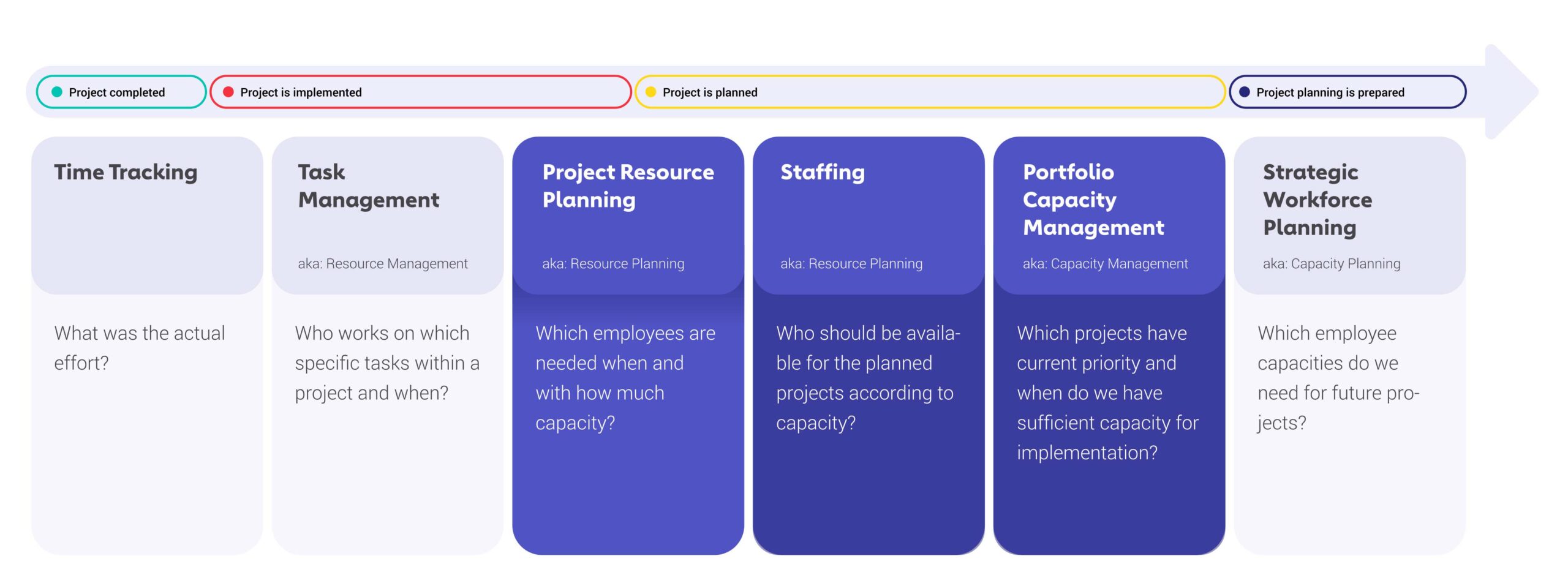What is capacity planning? Are capacity planning and resource planning the same thing? Why do we distinguish between operational and strategic capacity planning? And how does all of this relate to capacity and resource management?
If this isn’t your first article on the topic, you’ve probably already noticed that you can get very different and sometimes very ambiguous answers to these questions. At Meisterplan, even we had to discuss these terms extensively before coming up with answers which, in our view, clear up some of the murkiness of the matter.
Before you accompany us on this journey into the complicated world of capacity planning terms, we have to provide a small disclaimer: in this blog post, we discuss capacity planning solely in a project management context, and not, for example, machine capacities. Found what you’re looking for? Then let’s get started.
In this article, we’ll take a look at:
- what capacity planning and management are,
- the benefits of effective capacity planning,
- how capacity planning differs from resource planning and other related terms,
- practical activities involved in capacity planning,
- where the data for your planning comes from,
- why an effective tool makes all the difference,
- the most important KPIs to measure your success and
- how to best get started with capacity planning.
Definition
Capacity planning and capacity management are sub-disciplines of resource management, all of which fall under project management. The primary goal, as in all areas of resource management, is to align the demand for and the supply of employee capacities. This occurs both at an operational level in portfolio capacity management (i.e., short- to medium-term) and a strategic level through strategic workforce planning (i.e., long-term).
The short- to medium-term component involves knowing what capacities and skills are available at the company and planning projects to match this capacity. Long-term, on the other hand, involves anticipating future needs while taking measures to ensure those needs can be met.
The Benefits of Capacity Planning (Spoiler: It’s Worth It!)
Having all the data about your capacities and knowing how to use it provides significant advantages to any company, especially in comparison to others that rely on intuition for their planning.
When you always know what your company is capable of, and what it’s not, you can…
- plan more precisely and make reliable commitments to customers.
- utilize your resources as efficiently as possible.
- facilitate growth and explore new markets more easily.
- increase the quantity and quality of your projects.
- ensure long-term market competitiveness.
- make sure employees are challenged, but not overwhelmed.
- consistently complete your most important projects on time.
- recruit key resources or train existing resources to learn skills you need.
- motivate employees and retain them longer.
- respond flexibly to new circumstances and seize opportunities.
- save time and costs.
Have you already read our blog post on resource management? If so, you’ll notice that the benefits are quite similar. That’s because resource and capacity management go hand in hand. The next chapter explains how.
Capacity Planning Jargon Explained
In the following, we’ll delve deeper into the various vocabulary, activities, and best practices of the field. Walking through these topics at a fictional company with no semblance whatsoever to a real one will provide the easiest explanation.
TechDesign, Inc.
For the remainder of the blog, let’s imagine we work a company that develops and sells cloud software called TechDesign, Inc. TechDesign is divided into various departments: Development, Marketing, Sales, Customer Service, Internal IT, HR, etc. — a standard organizational structure. The primary objectives are to further develop the product, acquire more customers, and be a great employer.
At TechDesign, it’s essential to address questions related to resources and capacities because their goals can only be achieved through good planning. Doing so will ease their collaboration and help executive leadership, project management, department heads, team leads, and team members implement effective resource management and achieve their goals.
Resource Management
Resource management encompasses the whole of planning, coordination, and monitoring of employee capacities. It is generally used as an umbrella term for all the activities depicted in the graphic below. Nevertheless, many software providers use it to refer to managing tasks or assignments in day-to-day operations specifically.
We will use the first definition for resource management under which both portfolio capacity management (often referred to as operational capacity planning) and strategic workforce planning (often called strategic capacity planning) fall. If you are looking for more information on staffing and project resource planning, it’s best to read this blog post.
Note:
Of course, the process varies slightly at every company. The order of these steps and who is responsible for deciding each step is not always as clear cut as its portrayed above. Regardless of the size and structure of your company, the questions and problems are, in their essence, the same everywhere.
So, don’t get too hung up on the various terms circulating on the internet. Instead, focus on which problems you currently face and what you can do at your company specifically to solve them. Nevertheless, for the sake of discussion and understanding in this article, we will briefly discuss some key terms below.
Capacity vs. Resource, Management vs. Planning
Online, the terms “capacity planning” and “resource planning” are often used interchangeably. After all, both areas of responsibility deal with the capacities of employees, right?
“Resources” refers to actual physical employees, whereas “capacities” are more abstract. The term describes the total potential skills and work hours available at the company from the physical employees. When we talk about capacity planning and management, then, we find ourselves in a planning phase before project implementation.
Fine, but then what’s the difference between planning and managing? Management, as we understand it, is the coordination of something that is already concrete — in this case, the resources or capacities you currently have. Planning, on the other hand, relates more to the things that could or should be available in the future.
Portfolio Capacity Management
(Operational Capacity Planning)
Our example company, TechDesign, is in the midst of planning its current project portfolio. They’re creating the roadmap for the upcoming months based on the roles required for the projects, without assigning employees to specific projects yet.
After taking a look at all the ongoing and incoming projects, the portfolio coordinator at TechDesign is asking:
- What capacities and skills do we currently have?
- Which specific projects can we theoretically execute when and by what deadline?
- Which work packages can these projects be divided into, and what capacities and skills do we need for these work packages?
- When can these projects feasibly be completed?
- Are there any overlaps or dependencies that need to be considered?
Ideally, the relevant information can be found in a PPM (Project Portfolio Management) tool, in which employees, resource managers, and project managers record the current capacities, effort estimates, and other relevant data. Only the projects that are realistically feasible with the employees available are taken on.
Actual responsibility for project implementation can be clarified later in the process through staffing and project resource planning, in collaboration with project managers and resource managers (more on this here).
If there is a discrepancy between the supply of employee capacities and the demand from the project side, projects have to be . If the increased demand persists or even rises in the long term, it’s time for strategic workforce planning.
Strategic Workforce Planning
(Strategic Capacity Planning)
HR and management at TechDesign are primarily responsible for this sort of long-term planning. They receive information about resource and capacity demands from project and portfolio management and make decisions about future capacity. These revolve primarily around the question, “What do we want to be capable of at a specific point in time?” The answer to this can be found by breaking it down into more digestible questions like:
- How do we expect the market and order situation to develop?
- Are there departures in the company that need to be compensated for?
- Are we planning to research, produce more or even explore new markets?
- Are we currently facing frequent bottlenecks that we want to avoid in the future?
The more precisely TechDesign can answer these questions, the more realistic the forecasts and the more informed the decisions. With increased precision, companies know not just that they need to hire, but what skills to hire. Or not just that a portfolio adjustment is needed, but how best to adjust it. Here, we are operating at a higher-level, longer-term planning level that has the whole project portfolio in mind.
An Example:
Let’s assume that TechDesign wants to develop a new feature for their cloud software within in the next 3 months because they heard their competition will launch a new product during that time. To achieve this, the portfolio coordinator estimates a need for 5 developers, each working 40 hours per week, for the next 3 months (more on estimation later).
Fortunately, TechDesign has exactly 5 developers available, and none of them have planned vacations during this period; however, this project will consume 100% of their capacity. This means they won’t be available for other projects, and there won’t be room to compensate for any absences. The demand for these developers may thus be higher in practice than the estimate would have us believe. This leaves TechDesign with two options: increase supply (e.g. hire additional staff) or reduce demand (e.g. adjust the project planning).
Summarized
Capacity planning and management is essentially a balancing act between supply and demand. Your overarching goal is to ensure that your capacity supply of employees and skills closely matches the capacity demand from projects.
Project resource planning and staffing are thus more about HOW the available capacity supply is allocated to the requested projects. It involves examining each employee, their availability and skillset to assign them to a project where their potential can be best utilized (also known as allocation). In our example, a project manager might request the capacity of 5 developers. The respective team or department leader then decides which employees should and can be deployed.
Strategic Capacity Planning:
A Question of Data and Experience
Perhaps you’re wondering at this point how to reliably estimate capacity demand. Capacity supply can be roughly determined based on agreed working hours and the workload for daily tasks, but estimating capacity demand is an entirely different matter. The time employees need for a task can vary from case to case.
So, you estimate your capacity demand based on experience. Initially, this could involve looking at similar projects from other companies or forecasts provided by team members and team leads. If you’ve made a wrong estimate, you simply adjust your prediction up or down for the next time, and your planning becomes more precise with each iteration.
Of course, you can’t plan with 100% accuracy due to unforeseeable factors: employees might be unavailable, revenues could fluctuate, or the market could shift. But in regular operations, you ensure efficient and effective use of your employee resources and at least know, in exceptional circumstances, what options are available to you.
The Secret to Success:
One Place for All Capacity Data
Data and experience are valuable, but they are of limited use in your day-to-day operations if they are not centrally stored and accessible to those who need them.
If employee work hours and vacations (which determine capacity) are only found in HR software, others can’t easily make use of it. If project schedules are scattered across different spreadsheets managed by various project managers, critical information may be lost, overlooked, or outdated. If senior management has a strategy beautifully presented in some presentation but can’t locate it, it becomes impossible to plan projects aligned with that strategy.
Therefore, selecting the right tool is of the utmost importance. You should choose a tool that centralizes and harmonizes all this information to enable effective collaborative planning. Don’t get me wrong – let different teams continue using their specialized tools like JIRA, Asana, Personio and Co. for their specific tasks, but make sure crucial info from these platforms isn’t walled off from the people who need it for capacity and resource planning. Facilitating this will allow everyone in your organization to work together seamlessly.
Plan and Manage Your Capacity Accurately with Meisterplan
If you’re looking for a software that handles project resource planning, staffing, and portfolio capacity management like no other and can be seamlessly integrated with solutions for task/project management and strategic workforce planning, then Meisterplan is for you.
In Meisterplan, you can consolidate data such as capacities, timings, vacations, dependencies, and more from various tools within your organization without requiring your teams to change their working methods or tools. This is all reflected in an intuitive interface that shows you the real-time impacts of your changes and allows you to compare different capacity scenarios and report on their potential effects.
Sound good? Then get to know us.
Certain Succes or Likely Moonshot? The Most Important KPIs in Capacity Planning
Let’s assume that TechDesign has answered all the questions from the previous chapters because they:
- worked together with HR, employees, team and project leads, as well as management to get all the necessary information from these stakeholders.
- uploaded the data to a tool which displays it clearly, can be used to evaluate it, and can be used to plan accurately.
After this is done, which Key Performance Indicators (KPIs) best predict whether the company is “on track” and which measures would be suitable for the future? The formulas for calculation are quite simple, but, as before, having a tool that allows you to build reports according to your preferences helps make time for other things.
A Couple Examples:
Utilization Rate
Calculation: (Actual working hours / Available working hours) * 100
Bottleneck Rate
Calculation: (Overloaded time / Total working hours) * 100
Availability
Calculation: ((Available working hours - Actual working hours) / Available working hours) * 100
Project Completion Time
Calculation: (Project end date) - (Project start date)
Aside from quantifiable values like these, you can also incorporate qualitative factors such as surveys on employee and customer satisfaction into your evaluations. The key is to regularly analyze these metrics. By doing so, you continually improve in all areas of resource management and reap all the benefits mentioned.
The First Steps in Capacity Planning and Management
Many of the activities and questions from the article probably sound familiar. What’s working for you already? What questions can’t you answer yet? Who is responsible for what in your organization? It’s best to take stock and exchange ideas with colleagues, or even with our experts, on this topic.
Our fundamental recommendations are:
- Read more about the topic. When you master resource management and project portfolio management, you can significantly increase your success.
- Invest in a tool that combines resource and project portfolio management and allows you to consolidate data from various sources in your organization without requiring your teams to make significant adjustments.
- Collect all the data and start with the analyses and planning right away. Don't be afraid to make mistakes, as realistic capacity planning also relies on experiential knowledge.
- Contact us if you have any unanswered questions on this topic that we could help answer, and let us know where your challenges lie in capacity planning.





